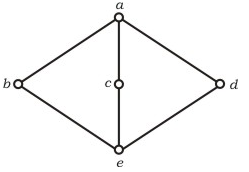Set Theory & Algebra
Question 21
Let E, F and G be finite sets. Let X = (E ∩ F) - (F ∩ G) and Y = (E - (E ∩ G)) - (E - F). Which one of the following is true?
Question 22
Given a set of elements N = {1, 2, ..., n} and two arbitrary subsets A⊆N and B⊆N, how many of the n! permutations π from N to N satisfy min(π(A)) = min(π(B)), where min(S) is the smallest integer in the set of integers S, and π(S) is the set of integers obtained by applying permutation π to each element of S?
Question 23
Let S = {1, 2, 3, ...., m}, m>3. Let x1, x2,....xn be the subsets of S each of size 3. Define a function f from S to the set of natural numbers as, f(i) is the number of sets [Tex]X_j[/Tex] that contain the element i. That is, f(i) = |{j|i [Tex]\\epsilon[/Tex] [Tex]X_j[/Tex]}|.
Then, [Tex]\\sum_{i=1}f(i)[/Tex] is :
Question 24
Let A, B and C be non-empty sets and let X = (A - B) - C and Y = (A - C) - (B - C). Which one of the following is TRUE?
Question 25
Question 26
The set {1, 2, 4, 7, 8, 11, 13, 14} is a group under multiplication modulo 15. The inverses of 4 and 7 are respectively
Question 27
Let R and S be any two equivalence relations on a non-empty set A. Which one of the following statements is TRUE?
Question 28
Let f: B → C and g: A → B be two functions and let h = f o g. Given that h is an onto function. Which one of the following is TRUE?
Question 29
What is the minimum number of ordered pairs of non-negative numbers that should be chosen to ensure that there are two pairs (a, b) and (c, d) in the chosen set such that "a ≡ c mod 3" and "b ≡ d mod 5"
Question 30
Consider the binary relation:
S = {(x, y) | y = x+1 and x, y ∈ {0, 1, 2, ...}}
The reflexive transitive closure of S is
There are 121 questions to complete.
Last Updated :
Take a part in the ongoing discussion
